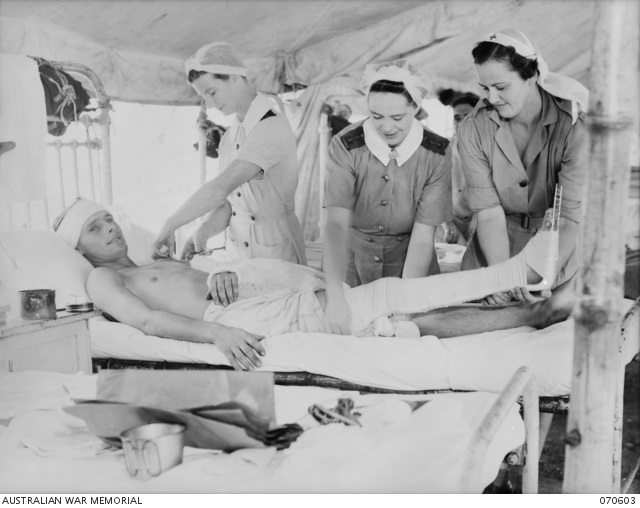80th Anniversary of the Australian Army Medical Women’s Service
By Jason Smeaton, PhD candidate at the Australian Catholic University
On this day in 1942, the Army formally established a women’s auxiliary to support the staff of military medical establishments. Fundamentally, the role of the auxiliary was to provide support as orderlies to the trained nurses of the Australian Army Nursing Service (AANS). Formed out of the Voluntary Aid Detachment (VAD) movement, it was part of the broader mobilisation of Australian women during the war and the creation of various women’s auxiliary services. Given official status as an Army auxiliary, this service became known as the Australian Army Medical Women’s Service (AAMWS). The Navy and Air Force never called upon VADs, and instead relied on their own nursing services.
Alice Appleford (nee Ross King) is just one of the roughly 8,500 women who served in the AAMWS during the Second World War. She exemplifies the deep connection that existed between the nursing profession, the Army, and the AAMWS nursing orderly.
Following her First World War service where she was just one of seven Australian Army nurses to receive the Military Medal, Alice Ross King became a notable nurse in Australia. But, like many women, after her marriage to fellow veteran, Sydney Appleford, Alice had to resign her position. This, however, was not the end of her commitment to nursing or the military.
In the interwar years, Alice joined the VAD movement. Here, with her nursing and military experience, Alice contributed to the recruitment and training of civilians in first aid and home nursing throughout the Gippsland region in Victoria. As civilians, the VAD prepared to support the military medical and nursing services as a technical reserve during an emergency. To Alice, her work with the VAD and then the AAMWS ensured that she was helping the service become a proficient auxiliary to the AANS.
Such a situation occurred when war broke out in 1939. At first, women volunteered as VADs in military hospitals. By mid-1940, the Army Director-General of Medical Services, Major General Rupert Downes, recognised their efforts and encouraged the Minister for the Army, Percy Spender, to enrol VADs in paid full-time service. From December 1940, women were enrolled in the Army as VADs and paid for their work as orderlies. With the creation of the AAMWS in December 1942, the women serving as VADs in the Army were absorbed into the new auxiliary. Alice Appleford was given the rank of major and made leader of the AAMWS in Victoria.
As VADs, these servicewomen were posted to Ceylon (now Sri Lanka) and the Middle East and served on hospital ships. Then, as AAMWS, they staffed troop trains, worked in northern Australia, and served in the Pacific islands, including Morotai and New Guinea. They also staffed base and camp hospitals throughout Australia.
Servicewomen in the AAMWS took on a variety of roles in and around military medical establishments. Many served in hospital wards as nursing orderlies. Others became technicians in laboratories and blood banks. AAMWS also worked in hospital kitchens and laundries, and ran the postal and telephone services. As AAMWS Private Sheila Sibley put it, ‘Marching side by side with the Lady of the Lamp … you’ll find the lady of the laundry, and her good companions, the ladies of the skillet and the scrubbing brush’.
Assisting the registered nurses and medical officers, the AAMWS turned to any job that needed doing. Serving on Bougainville, Maud Whiting worked as a theatre orderly, monitoring the use of instruments and sterilising equipment. Maud also became an expert in mending and preparing all manner of surgical equipment for reuse. Because of the shortage of resources, especially on the islands, surgical gloves with holes were not disposed of, but were patched over by AAMWS. ‘Sister would check them after and blow into them to see if there was any air coming in,’ Maud recalled. ‘And they were worn over and over again.’
One AAMWS, who had trained with the local Warragul VAD formed by Alice Appleford, was Janet ‘Jean’ Wallace. Before the war, Jean had no ambition to become a nurse. But as an AAMWS, she got to see and experience what it was like to be one. Serving in Katherine in the Northern Territory, Jean recalled that, ‘There was always something happening. New patients, new treatments to learn, and lectures to attend’.
Jean immersed herself in her nursing duties, which included distributing mixtures and medications, ensuring patients were fed according to any special diets, conducting urine tests, and checking temperatures. She also extended her knowledge of nursing by attending lectures on caring for and treating surgical cases, tropical diseases, pathology, and psychology. Under Alice’s watchful eye in the AAMWS, the experience Jean gained saw her return to Warragul after the war to begin her formal training to become a registered nurse.
Through the guidance of leaders such as Alice, and the dedication to duty as shown by Maud, Jean and many others, the AAMWS made a positive contribution to the war effort, and to the nursing profession after the war.

Left: Members of the Australian Army Medical Women's Service (AAMWS) in 1944.

Below: Two Australian Army Nursing Service sisters and a member of the AAMWS (left) attending a patient at the 2/1st Australian General Hospital, New Guinea, 1944.
